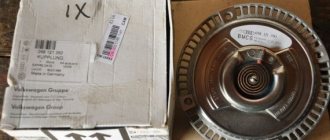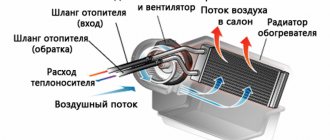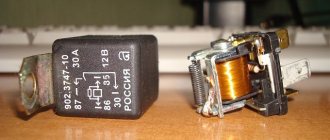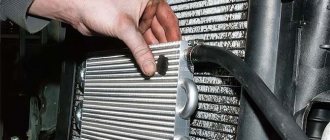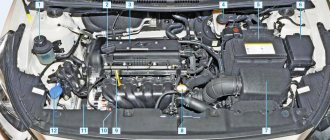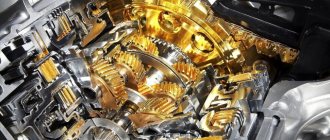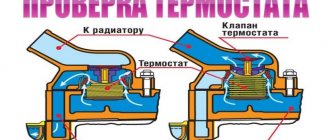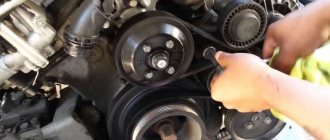With the onset of summer, some motorists are faced with the need to replace the electric cooling fan. How not to make a mistake with the choice of such an important component, on which the issue of engine “survival” in traffic jams and in hot weather often depends?
The electric fan produced by the Kaluga Automotive Electrical Equipment Plant (KZAE) model 70.3730 actually has a much wider application. It can be installed on the engines of almost all domestic cars (ZAZ, VAZ, AZLK, IZH, GAZ and ZIL). The main thing is that its parameters are suitable - 110 W and 2600 min-1, as evidenced by the corresponding inscription on the packaging and the installation drawing. KZAE mod. 70.3730 has an 8-blade impeller without a rim, unlike its competitors in the test. It is packed in a cardboard box. However, apart from the electric fan, nothing else could be found in it. The manufacturer's guarantees were also unknown.
Before we started testing the electric fan, we measured the diameter of the impeller (see table at the end of the article). The next step was to measure energy consumption and impeller rotation speed. The measurements were carried out in two modes: at the moment of start-up and during steady operation. Based on the measurement results, it turned out that the test subject was the most “economical” among competitors, but the impeller rotation speed turned out to be the lowest.
Having completed the measurements, we began disassembling the fan. The KZAE electric fan impeller has the same mounting as PEKAR and Kraft, and they can be interchangeable with each other. It is held on the shaft using pins, which are inserted into a through hole on the shaft of the electric motor. The impeller is secured with a regular nut and washer. The KZAE electric motor is dismountable, unlike the LUZAR fan. It is structurally made with two bearings: on one side the shaft rests on a ball bearing, on the other on a bushing (see photo). This collapsible design is more preferable from the point of view of maintainability. The electric motor brushes have a cross-section of 6.5x6.5 mm and a length of 11 mm. The connection of the brush units is made using wires. In this case, mediocre soldering was discovered.
The electric fan from St. Petersburg auto parts manufacturer PEKAR is much more specific, since it has an address message in the form of catalog number 2103-1308008. It also has an 8-blade impeller and rim to reduce vibration and noise. In addition to the packaging, a technical data sheet and fasteners for mounting the electric fan were included in the cardboard box. Manufacturer's warranty is two years.
Having carried out measurements as with the previous test subject, we disassembled the fan. The PEKAR electric fan impeller, as already noted, has the same mounting with KZAE and Kraft and can also be interchangeable with each other. It is held on the shaft by pins inserted into a through hole on the motor shaft. The impeller is secured with a nut with a lower toothed rim. The electric motor is also structurally made with two bearings. The cross section of the brushes is 6.5x6.0 mm, length - 11 mm. The brush units are connected using wires, just like in KZAE, but the soldering of the wires is performed at a more technological level. The electric fan under the German brand Kraft (KT 104500) is exactly like the one from St. Petersburg. At the same time, we experienced a certain feeling of déjà vu. Exactly the same impeller and engine dimensions. However, this is where the similarity ends: no passport, no fasteners, and the warranty is only one year. Having measured the diameter of the impeller (note that for fans with a rim, the diameter of the impeller was measured along the inner rim), as well as the energy consumption and rotation speed of the impeller, we began to disassemble this fan and found complete similarities with the PEKAR electric fan.
The LUZAR electric fan is strikingly different from its counterparts with eight profile blades united by a single rim. In addition to the fan, we found a technical data sheet and fasteners in the cardboard box. The warranty for this electric fan is two years. Based on the results of measurements of energy consumption and impeller rotation speed, the fan turned out to be in the “golden mean”. At the same time, it has the highest impeller rotation speed.
Analysis showed that the impeller of the LUZAR electric fan is held by a groove on the electric motor shaft and is fixed with a nut with a left-hand thread that has a lower toothed rim. In addition, the nut is secured with a thread locker. Due to this, the impeller of the LUZAR electric fan is not interchangeable with other electric fans. The LUZAR electric motor is also made according to a two-bearing design, like the previous tests, but on two ball bearings. It follows from this that collapsible structures are more preferable from the point of view of maintainability, at the same time, two bearings on the shaft make the structure more reliable and durable. Let's move on to the brush assembly. The electric motor of the LUZAR fan uses spark arresting chokes (twisted copper wire). This design significantly extends the life of the product. The cross section of the brushes is 7.0x8.0 mm with a length of 20 mm. The connecting wires of the brushes also have a larger cross-section (help reduce heating). To connect the brush assemblies and spark-extinguishing chokes, brass plates are used, to which the supply wires and brush wires are welded with special conductive welding pliers (in all likelihood, this leads to a decrease in transition resistance and less heating).
When examining all four rotors in the LUZAR fan electric motor, a double rotor winding was discovered. Its use precisely leads to increased magnetic flux and electric motor power with the same dimensions. Comparability of prices for the tested fans revealed some inadequacy in the supply of goods according to the “price-quality” criterion. A higher price is requested for frankly low quality. If we take into account the data obtained during testing, we are inclined to give our preferences in favor of the LUZAR fan.
We recommend: Means for washing diesel particulate filters
Cooling system fan: why and for what?
First, let's remember why this fan is needed in the first place. This element is part of the car engine cooling system, the operating principle of which we will now briefly consider.
The vast majority of modern passenger cars are equipped with a liquid cooling system. This means that the coolant in it is a special liquid - distilled water or antifreeze.
The source of heat, as you know, is the motor itself, which heats up quite noticeably during operation. To rid the heart of the car from such a misfortune, it is necessary to forcibly cool it.
To do this, channels are made in key parts of the power unit through which that same liquid flows. Having excellent thermal conductivity, it removes unnecessary heat, heating itself. It is clear that no one will add cold water to the system while driving, so before it reaches the engine again, its temperature must be lowered.
To do this, the system contains a pump pumping liquid, an expansion tank, a thermostat that maintains a certain heating level necessary for normal engine operation, a radiator - the main element for lowering the temperature of the liquid, and, in fact, a radiator fan.
The latter has the function of improving cooling efficiency - it increases the flow of incoming air, due to which the liquid passing through the radiator cools better. Typically, the fan does not work constantly - the engine control unit turns it on only when the engine or antifreeze temperature sensor signals overheating, but there are exceptions. About them further...
Engine cooling fan design
Structurally, a fan for cooling a car engine is a simple mechanism consisting of a pulley on which blades (impeller) are located. They are installed with a certain angle of inclination relative to the plane of rotation, which improves their aerodynamic characteristics and increases the intensity of air injection. The number of blades (from 4 or more), as well as their geometric dimensions (fan diameter, frequency of location) depend on the car model and are selected individually.
Modern cars are equipped with a so-called combined cooling system, which consists not only of a fan, but also has a radiator and special circuits (lines) with coolant. That’s why the engine “cooler” is often called a radiator fan.
Some vehicle configurations may use dual engine cooling fans, which have two pulleys with independent blades. They can be brought into operation simultaneously or separately, since each has its own connection system.
Engine cooling fan location
When the pulley rotates intensively, the air flow is “sucked in” from the outside using the blades. This increases the volume of air passing through the radiator, which ensures its more efficient operation and accelerates the process of heat removal. To force the rotation of the pulley (blades) and provide the required speed, several types of drive can be used:
- mechanical;
- hydromechanical;
- electric.
How does a mechanical drive work?
The simplest type of fan drive for cooling an engine radiator is based on transmitting rotational motion from the crankshaft using a belt. This method is completely mechanical and permanent, ensuring that the “cooler” starts up synchronously with the operation of the engine.
Despite the simplicity of the design, such a drive reduces the useful power of the motor, since part of the energy is spent on pumping air. In addition, there is no possibility of adjusting the intensity of the blades. Due to these features, mechanical drives are practically not used in modern cars.
Radiator fan drive types
The fan drive rotates it. The drive comes in three types:
- mechanical;
- hydromechanical;
- electric.
The simplest type is mechanical. It is a permanent drive from the crankshaft via a belt drive. The fan starts simultaneously with the engine turning on. It is worth taking into account that this drive reduces the power of the motor, as it spends a lot of energy rotating the fan.
Currently, this type of fan drive is practically not used.
In the hydromechanical type of drive, unlike the previous one, the blades are connected to the pulley using a coupling (viscous or hydraulic).
The viscous coupling is connected to the engine crankshaft. Clutch locking occurs if the temperature of the silicone fluid filling the clutch rises. This leads to increased load on the engine. In turn, blocking the clutch helps turn on the fan. In a hydraulic coupling, locking occurs due to a change in oil volume.
The most common type of drive in modern passenger cars is electric. It consists of a sensor, an electronic engine control unit, an engine start relay and the electric motor itself. The sensor records the temperature of the coolant in the engine. If it rises above normal, the sensor transmits a signal to the electronic control unit, which, in turn, processes it and activates the fan relay.
In cars with climate control, there are usually two fans, each servicing its own switching relay.
Principles of designing cooling systems
A decrease in the efficiency of the cooling system leads to an increase in the temperature of the pistons and a decrease in the gaps between the piston and the cylinder. Thermal gaps are reduced to zero. The piston touches the cylinder walls, scoring occurs, overheated oil loses its lubricating properties and the oil film breaks. This mode of operation can lead to engine seizure. Overheating is accompanied by uneven expansion of the cylinder head, mounting bolts, engine block, etc. Subsequent destruction of the engine is inevitable: cracks in the cylinder head, deformation of the joint planes of the head and the cylinder block itself, cracks in the valve seats, etc. — it’s unpleasant to even list all this, so it’s better not to let it come to that!
The engine and oil cooling system is designed to prevent such developments, but in order for the system to cope with its tasks, it is necessary to use high-quality coolant (coolant). Low-freezing coolants are called antifreeze - from the English word “antifreeze”. Previously, coolants were prepared based on aqueous solutions of monohydric alcohols, glycols, glycerin and inorganic salts. Currently, preference is given to monoethylene glycol, a colorless syrupy liquid with a density of approximately 1.112 gcm2 and a boiling point of 198 g. The task of coolant is not only to cool the engine, but also not to boil over the entire operating temperature range of the engine and its components, to have high heat capacity and thermal conductivity, not to foam, not to have a harmful effect on pipes and seals, and to have lubricating and anti-corrosion properties.
In the 70s, antifreeze was produced based on an aqueous solution of monoethylene glycol with a crystallization temperature of 40 degrees. It did not require dilution with water when added to the cooling system. This drug was called TOSOL - after the name of the laboratory “Technology of Organic Synthesis”. Because the name is not patented, then TOSOL is a ready-to-use product, and “antifreeze” is a concentrated solution (although TOSOL is also antifreeze).
Ready-made antifreezes are colored for safety and catchy colors are chosen: blue, green, red. During operation, antifreeze loses its beneficial properties - its anti-corrosion properties decrease, and the tendency to foam increases. The service life of domestic coolants is from 2 to 5 years, imported 5-7 years.
The figure below shows a diagram of the car's cooling system. There is nothing special or complicated in the cooling system and yet...
Rice. 1 - engine, 2 - radiator, 3 - heater, 4 - thermostat, 5 - expansion tank, 6 - radiator cap, 7 - upper pipe, 8 - lower pipe, 9 - radiator fan, 10 - fan switch sensor, 11 - sensor temperature, 12 - pump.
When the engine starts, the water pump begins to rotate. The pump drive may have its own pulley driven by an accessory belt or driven by the rotation of a timing belt. The cooling system contains an impeller, which rotates and drives the coolant. To quickly warm up the engine, the system is “shorted”, i.e. The thermostat is closed and does not allow fluid to enter the radiator. As the temperature of the coolant rises, the thermostat opens, transferring the system to another state when the coolant passes along a long path - through the radiator of the cooling system (the short path is blocked by the thermostat). Thermostats have different opening characteristics. Typically the opening temperature is marked on the edge. It’s probably not worth explaining the design of the radiator. A fan switch sensor is installed at the bottom of the radiator. If the coolant temperature reaches a certain value, the sensor will close, and because If it is electrically connected to the break in the power supply circuit of the electric fan, then when it is shorted, the cooling system fan should turn on. As the coolant cools, the fan turns off and the thermostat closes the long path to a short one. It's simple, but not very...
This scheme is the basis, but life does not stand still and various manufacturers are improving cooling systems. On some cars you will not find a sensor for turning on the cooling fan, because... The fan is turned on by the engine ECU depending on the readings of the coolant temperature sensor. It is worth paying attention to the situation in which when the ignition is jammed, the cooling system fan immediately turns on. Either the temperature sensor is faulty, or its circuits are damaged, or the engine ECU itself is faulty - it “does not see” the engine temperature and, just in case, immediately turns on the fan.
On some cars, special electric valves are installed on the way to the heater, allowing or blocking the path of coolant (BMW, MERCEDES). Such valves sometimes “help” the cooling system fail.
Electric cooling fans test
With the onset of summer, some motorists are faced with the need to replace the electric cooling fan. How not to make a mistake with the choice of such an important component, on which the issue of engine “survival” in traffic jams and in hot weather often depends?
The electric fan produced by the Kaluga Automotive Electrical Equipment Plant (KZAE) model 70.3730 actually has a much wider application. It can be installed on the engines of almost all domestic cars (ZAZ, VAZ, AZLK, IZH, GAZ and ZIL). The main thing is that its parameters are suitable - 110 W and 2600 min-1, as evidenced by the corresponding inscription on the packaging and the installation drawing. KZAE mod. 70.3730 has an 8-blade impeller without a rim, unlike its competitors in the test. It is packed in a cardboard box. However, apart from the electric fan, nothing else could be found in it. The manufacturer's guarantees were also unknown.
Before we started testing the electric fan, we measured the diameter of the impeller (see table at the end of the article). The next step was to measure energy consumption and impeller rotation speed. The measurements were carried out in two modes: at the moment of start-up and during steady operation. Based on the measurement results, it turned out that the test subject was the most “economical” among competitors, but the impeller rotation speed turned out to be the lowest.
Having completed the measurements, we began disassembling the fan. The KZAE electric fan impeller has the same mounting as PEKAR and Kraft, and they can be interchangeable with each other. It is held on the shaft using pins, which are inserted into a through hole on the shaft of the electric motor. The impeller is secured with a regular nut and washer. The KZAE electric motor is dismountable, unlike the LUZAR fan. It is structurally made with two bearings: on one side the shaft rests on a ball bearing, on the other on a bushing (see photo). This collapsible design is more preferable from the point of view of maintainability. The electric motor brushes have a cross-section of 6.5x6.5 mm and a length of 11 mm. The connection of the brush units is made using wires. In this case, mediocre soldering was discovered.
The electric fan from St. Petersburg auto parts manufacturer PEKAR is much more specific, since it has an address message in the form of catalog number 2103-1308008. It also has an 8-blade impeller and rim to reduce vibration and noise. In addition to the packaging, a technical data sheet and fasteners for mounting the electric fan were included in the cardboard box. Manufacturer's warranty is two years.
Having carried out measurements as with the previous test subject, we disassembled the fan. The PEKAR electric fan impeller, as already noted, has the same mounting with KZAE and Kraft and can also be interchangeable with each other. It is held on the shaft by pins inserted into a through hole on the motor shaft. The impeller is secured with a nut with a lower toothed rim. The electric motor is also structurally made with two bearings. The cross section of the brushes is 6.5x6.0 mm, length - 11 mm. The brush units are connected using wires, just like in KZAE, but the soldering of the wires is performed at a more technological level. The electric fan under the German brand Kraft (KT 104500) is exactly like the one from St. Petersburg. At the same time, we experienced a certain feeling of déjà vu. Exactly the same impeller and engine dimensions. However, this is where the similarity ends: no passport, no fasteners, and the warranty is only one year. Having measured the diameter of the impeller (note that for fans with a rim, the diameter of the impeller was measured along the inner rim), as well as the energy consumption and rotation speed of the impeller, we began to disassemble this fan and found complete similarities with the PEKAR electric fan.
The LUZAR electric fan is strikingly different from its counterparts with eight profile blades united by a single rim. In addition to the fan, we found a technical data sheet and fasteners in the cardboard box. The warranty for this electric fan is two years. Based on the results of measurements of energy consumption and impeller rotation speed, the fan turned out to be in the “golden mean”. At the same time, it has the highest impeller rotation speed.
Analysis showed that the impeller of the LUZAR electric fan is held by a groove on the electric motor shaft and is fixed with a nut with a left-hand thread that has a lower toothed rim. In addition, the nut is secured with a thread locker. Due to this, the impeller of the LUZAR electric fan is not interchangeable with other electric fans. The LUZAR electric motor is also made according to a two-bearing design, like the previous tests, but on two ball bearings. It follows from this that collapsible structures are more preferable from the point of view of maintainability, at the same time, two bearings on the shaft make the structure more reliable and durable. Let's move on to the brush assembly. The electric motor of the LUZAR fan uses spark arresting chokes (twisted copper wire). This design significantly extends the life of the product. The cross section of the brushes is 7.0x8.0 mm with a length of 20 mm. The connecting wires of the brushes also have a larger cross-section (help reduce heating). To connect the brush assemblies and spark-extinguishing chokes, brass plates are used, to which the supply wires and brush wires are welded with special conductive welding pliers (in all likelihood, this leads to a decrease in transition resistance and less heating).
When examining all four rotors in the LUZAR fan electric motor, a double rotor winding was discovered. Its use precisely leads to increased magnetic flux and electric motor power with the same dimensions. Comparability of prices for the tested fans revealed some inadequacy in the supply of goods according to the “price-quality” criterion. A higher price is requested for frankly low quality. If we take into account the data obtained during testing, we are inclined to give our preferences in favor of the LUZAR fan.
Radiator fans - purpose and design
The radiator cooling fan is used for air cooling, which, together with liquid cooling, ensures optimal temperature conditions for the engine. To increase the efficiency of liquid cooling, a radiator is used: oncoming air passes through its cells and cools the liquid. But at low speeds or in city traffic jams, the air flow is insufficient. To avoid overheating, a fan is turned on, which directs air to the radiator, cooling it.
We recommend: Fuel pump for VAZ 2110
On older models and modern SUVs with a longitudinally mounted engine, a mechanical cooling fan drive is used. In older cars it works constantly; later they began to install a viscous coupling, which turns it off if necessary. Used on large trucks and SUVs. The advantage is that it is not afraid of water, unlike electric fans.
Electrically driven fans
The radiator and engine cooling fan with electric drive has a more complex design than the previous system. In addition, it is more modern, so it is found on many new cars. The device includes an electric motor, a temperature sensor, an electronic control unit, and a cooling fan relay. Most devices have two temperature sensors. One is equipped with a pipe coming out of the radiator. The second sensor is built directly into the thermostat housing, and can also be located in the pipe coming out of the motor. The difference in sensor readings affects the operation of the cooling fan control unit.
We recommend: Car interior volume sensor for Starline alarm
Setting the operating mode of the device's electric motor requires an air flow meter, as well as a sensor that monitors the crankshaft speed. The control unit will receive the corresponding signals from all sensors and process them. The cooling fan relay is then activated, which will monitor the rotation speed of the impeller after the system is turned on. Such devices are often installed by car manufacturers nowadays.
Variety of fans
The radiator cooling fan itself is not something original. Structurally, it is the same as a household fan that saves you and me from the heat - an impeller that pumps air and its drive. In the automotive world, the impeller can spin in different ways. There are the following methods:
- mechanical;
- electric;
- hydraulic or hydromechanical.
The first method is quite archaic; it is almost impossible to find it on a modern passenger car, but on trucks and tractors it is still quite possible. The main feature of a mechanical drive is a direct connection with the engine crankshaft, which entails, albeit a small, extraction of useful power.
Another nuance is that the fan rotates constantly while the motor is running. This is the exception we mentioned above.
The most common is an electric radiator fan. It is based on a conventional electric motor, powered from the on-board network. The convenience of such a scheme is obvious.
Firstly, it can be easily controlled - the airflow is turned on automatically by the electronics when it detects an excess temperature. As a rule, this happens during long periods of parking when there is no incoming air flow.
Secondly, they are cheap - electric motors are not in short supply, and the entire structure is easy to replace.
Hydraulic options are found under the hoods of both trucks and cars, but, however, not as often as electric ones. Such fans are ideologically closer to mechanical ones, since they are driven by the engine crankshaft, but in their case, rotation is transmitted through viscous or hydraulic couplings, which allows maintaining stable impeller speeds.
As it turned out, fellow car enthusiasts had something to tell about even such a simple thing as a radiator fan. See you on the pages of our blog, subscribe so as not to miss fresh and interesting articles!
Radiator fan malfunctions and their consequences
The main task of the engine fan is to “suck” cooled air from the outside through the radiator into the engine compartment of the car. In fact, cooling is carried out by a liquid system, and blowing only speeds up this process. On the other hand, at high ambient temperatures, as well as when the car sits for long periods in traffic jams without additional cooling, the engine can become very hot. This means that the serviceability of this unit should not be neglected.
Where does the cooling fan blow?
In this article we cannot ignore the question of where the mechanism that interests us blows. This is exactly what users ask experts and fellow car enthusiasts on dozens and hundreds of forums dedicated to vehicle maintenance. In fact, the answer to this is very simple.
The very purpose of the cooling device and the principle of its operation, described above, tells us that it blows exclusively on the engine, sucking in cold air through the radiator.
If in your car the air flow is directed not to the engine, but to the radiator, this only means that the fan was connected incorrectly after maintenance or repair work. Most likely, the terminals were simply mixed up. Install them correctly and never again wonder where the fan should direct the flow of cooled air.
Diagnosis of cooling fan faults
Neither the most innovative electric motor with high power, nor the ultra-reliable control unit or controller is able to protect the cooling system one hundred percent from breakdowns. Considering that a failed cooling fan that blows in the wrong direction or does not rotate at all can cause engine overheating, it is necessary to constantly monitor its normal functioning.
Timely repair of system components will save your car from many troubles, but it is important to correctly determine the cause of the fan failure. In other words, you first need to find a problem where, for example, the crankshaft speed controller or control unit or electric motor does not work. Any driver can diagnose fan malfunctions based on the recommendations below.
